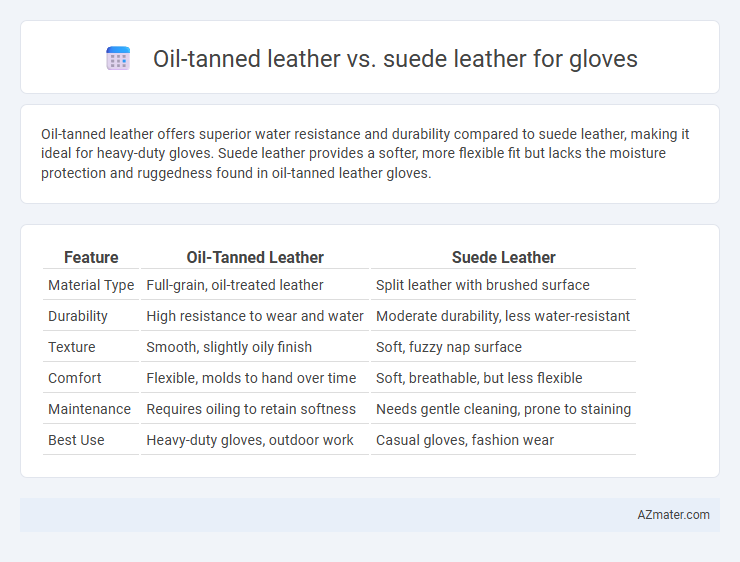Oil-tanned leather offers superior water resistance and durability compared to suede leather, making it ideal for heavy-duty gloves. Suede leather provides a softer, more flexible fit but lacks the moisture protection and ruggedness found in oil-tanned leather gloves.
Table of Comparison
| Feature | Oil-Tanned Leather | Suede Leather |
|---|---|---|
| Material Type | Full-grain, oil-treated leather | Split leather with brushed surface |
| Durability | High resistance to wear and water | Moderate durability, less water-resistant |
| Texture | Smooth, slightly oily finish | Soft, fuzzy nap surface |
| Comfort | Flexible, molds to hand over time | Soft, breathable, but less flexible |
| Maintenance | Requires oiling to retain softness | Needs gentle cleaning, prone to staining |
| Best Use | Heavy-duty gloves, outdoor work | Casual gloves, fashion wear |
Introduction: Oil-Tanned Leather vs Suede Leather Gloves
Oil-tanned leather gloves are renowned for their durability, water resistance, and rugged texture, offering superior protection and longevity in harsh working conditions. Suede leather gloves provide a softer, more flexible feel with enhanced breathability, making them ideal for light-duty tasks and precision work. Choosing between oil-tanned and suede leather depends on the desired balance of toughness versus comfort and dexterity.
What is Oil-Tanned Leather?
Oil-tanned leather is a durable, water-resistant material treated with oils and waxes during the tanning process to enhance flexibility and longevity, making it ideal for gloves used in heavy-duty or outdoor environments. This type of leather retains natural oils, resulting in a rich texture and increased resistance to stains, moisture, and wear compared to suede leather. While suede leather offers a softer, more breathable fabric, oil-tanned leather delivers superior protection and durability, essential for gloves exposed to harsh conditions.
What is Suede Leather?
Suede leather is a type of leather with a napped finish, created by sanding the inner surface of animal hide, resulting in a soft, fuzzy texture ideal for gloves requiring flexibility and breathability. Unlike oil-tanned leather, which is treated with oils to enhance water resistance and durability, suede offers a more delicate feel but requires careful maintenance to avoid staining and moisture damage. Suede gloves excel in providing comfort and style but may not perform as well in harsh outdoor conditions compared to oil-tanned gloves.
Appearance and Texture Comparison
Oil-tanned leather boasts a rich, glossy finish with a rugged, slightly waxy surface that enhances durability and water resistance, making gloves visually striking and robust. Suede leather offers a soft, matte texture with a velvety nap that provides a delicate and luxurious appearance, though it is more susceptible to stains and wear than oil-tanned leather. The contrast lies in oil-tanned leather's smooth, polished look versus suede's fuzzy, tactile feel, influencing both style and maintenance of gloves.
Durability and Strength Differences
Oil-tanned leather offers superior durability and strength for gloves due to its dense fiber structure and water-resistant treatment, making it ideal for heavy-duty use and prolonged wear. In contrast, suede leather, created from the underside of the hide, provides a softer texture but is less resistant to abrasion and moisture, reducing its lifespan under rigorous conditions. Choosing oil-tanned leather ensures enhanced protection and longevity, while suede prioritizes comfort and flexibility at the expense of robustness.
Water and Stain Resistance
Oil-tanned leather gloves offer superior water and stain resistance due to their dense, wax-infused surface that repels moisture and prevents dirt absorption. Suede leather gloves, with their napped, porous texture, are more vulnerable to water damage and stains, requiring additional treatments to enhance durability. For tasks exposed to wet or dirty environments, oil-tanned leather gloves provide longer-lasting protection and easier maintenance.
Comfort and Flexibility
Oil-tanned leather offers superior durability and water resistance, making gloves comfortable for prolonged wear in harsh conditions while maintaining flexibility through natural oils. Suede leather provides a softer touch and excellent breathability, enhancing comfort with a supple feel but may sacrifice some flexibility and durability compared to oil-tanned options. Both materials balance comfort and flexibility differently, with oil-tanned excelling in rugged environments and suede favored for lighter, more tactile use.
Maintenance and Cleaning Tips
Oil-tanned leather gloves boast a durable, water-resistant finish that repels moisture and requires minimal cleaning; simply wipe with a damp cloth and apply leather conditioner periodically to maintain suppleness. Suede leather gloves demand gentler care, using a soft brush to remove dirt and a specialized suede cleaner for stains, avoiding water to prevent damage and stiffness. Proper storage away from direct sunlight and humidity preserves the texture and lifespan of both oil-tanned and suede leather gloves.
Best Uses for Each Leather Type
Oil-tanned leather offers exceptional durability, water resistance, and protection, making it ideal for work gloves, outdoor activities, and heavy-duty tasks. Suede leather provides superior flexibility, breathability, and a softer feel, best suited for casual gloves, driving gloves, and fashion accessories. Choosing between these leathers depends on the intended use--oil-tanned leather for rugged performance and suede for comfort and style.
Which Leather is Best for Gloves?
Oil-tanned leather offers superior durability, water resistance, and excellent protection, making it ideal for work gloves and outdoor activities. Suede leather provides a softer feel and better grip, but it is less resistant to moisture and wear, making it suited for lighter, fashion-oriented gloves. For gloves requiring long-lasting performance and protection, oil-tanned leather is generally the best choice.

Infographic: Oil-tanned leather vs Suede leather for Glove
 azmater.com
azmater.com